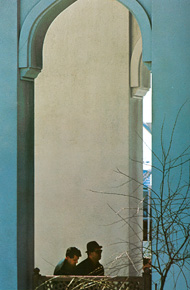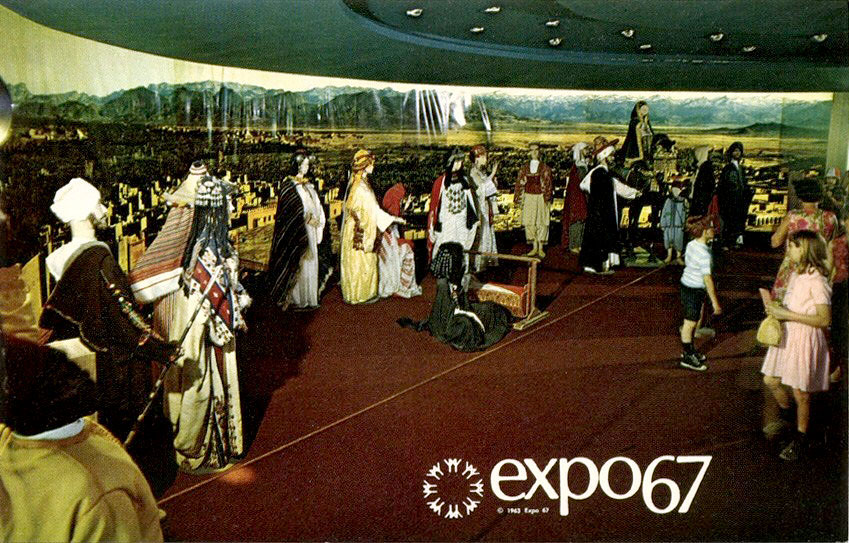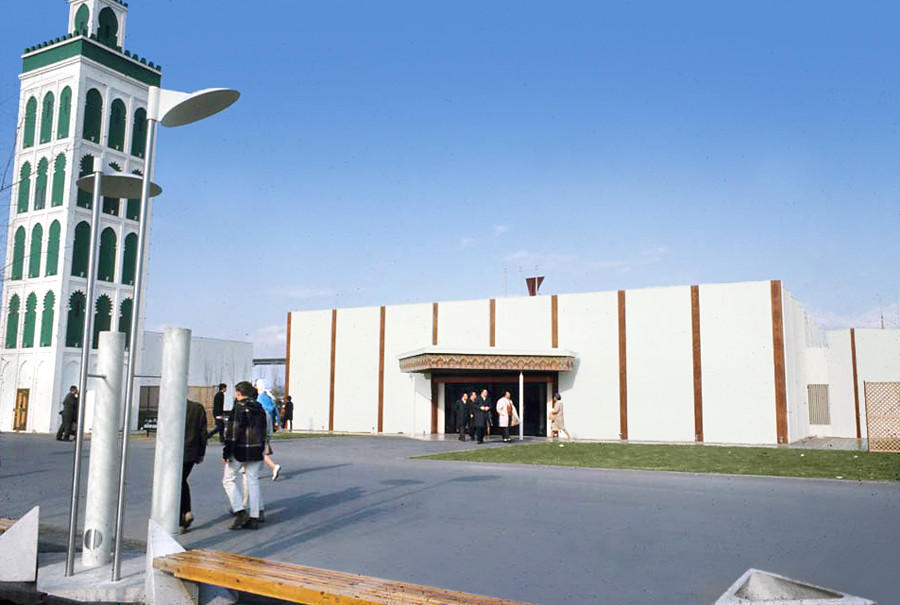The Morocco Pavilion
Located on Île-Notre-Dame between the pavilions of Tunisia and Ethiopia, Morocco's participation at Expo 67 was a traditionally-styled pavilion 72 feet in diameter and 14 feet high. Its shape was inspired by a typically Moroccan motif - the 8 point star - with wood and plaster sculptures throughout, and a floor covered in Moroccan mosaics.
Adjoining the main pavilion was a 65-foot minaret, embellished with ornamental arches.

 Pillbox hatted hostess (left) ornamental arch (right).
Pillbox hatted hostess (left) ornamental arch (right).
Hostesses dressed in sunny yellow uniforms were on hand to guide visitors through a variety of exhibits that told Morocco's story in 2 parts: its contributions to civilisation prior to its 1956 independance, and its achievements after.
Adjoining the main pavilion was a 65-foot minaret, embellished with ornamental arches.

 Pillbox hatted hostess (left) ornamental arch (right).
Pillbox hatted hostess (left) ornamental arch (right).Hostesses dressed in sunny yellow uniforms were on hand to guide visitors through a variety of exhibits that told Morocco's story in 2 parts: its contributions to civilisation prior to its 1956 independance, and its achievements after.
A large cupola in the center of the pavilion featured 2 luminous dioramas, complete with life-sized mannequins in traditional costume. One display showed the southern village of Tinerhir while the other featured the imperial city of Meknès, known as "The Versailles of Morocco". In another nearby exhibit, mannequins costumed as royal guards or as teachers represented the city of Fez, whose university was at least 400 years older than the Sorbonne.
In galleries around the central area, photographs, statues and more costumes reflected a past enriched by Morocco's proximity to other Mediterranean civilizations. Morocco's agricultural contributions to the world were highlighted: the cultivation of rice, buckwheat, sugarcane, ginger, cotton and silk, and fruits such as bananas, cherries, oranges, lemons and grapefruit.
Treasured relics were exhibited in adjacent display cases: a Neolithic vase, a Phoenician sphinx, a Punic lamp, a 14th-century frieze, a Berber bust from the Roman era. Other artifacts included ancient coins and jewels, daggers, ceramics, caskets, embroidery from North Morocco, forged iron from the city of Meknès, etc.
A 12th century Koran was on display in a section devoted to ancient manuscripts, where early Islamic advances in medicine, geometry and astronomy were discussed. A 14th century astrolabe, at once a scientific tool and a work of art, was a typical example of the refinement of the era.
In yet another section, photographs showed Morocco's natural beauty: spectacular mountains and valleys, deserts, coasts and beaches...
In galleries around the central area, photographs, statues and more costumes reflected a past enriched by Morocco's proximity to other Mediterranean civilizations. Morocco's agricultural contributions to the world were highlighted: the cultivation of rice, buckwheat, sugarcane, ginger, cotton and silk, and fruits such as bananas, cherries, oranges, lemons and grapefruit.
Treasured relics were exhibited in adjacent display cases: a Neolithic vase, a Phoenician sphinx, a Punic lamp, a 14th-century frieze, a Berber bust from the Roman era. Other artifacts included ancient coins and jewels, daggers, ceramics, caskets, embroidery from North Morocco, forged iron from the city of Meknès, etc.
A 12th century Koran was on display in a section devoted to ancient manuscripts, where early Islamic advances in medicine, geometry and astronomy were discussed. A 14th century astrolabe, at once a scientific tool and a work of art, was a typical example of the refinement of the era.
The section on modern Morocco showed recent progresses in the country: industrialization, increased school attendance, improved public hygiene and improvements in agriculture. Modern buildings harmonized with traditional architecture in an exhibit on Casablanca. Montages, models and photographs presented the new city of Agadir which had been devastated by an appalling earthquake some years before.
In yet another section, photographs showed Morocco's natural beauty: spectacular mountains and valleys, deserts, coasts and beaches...
The El Mansour restaurant served dishes which captured the lush and refined essence of Morocco's culture. Visitors could sample typical dishes such as mechoui or chicken served with prunes, in a relaxed and voluptuous atmosphere of soft divans and the scent of sandalwood and rose-water...
images: (1) personal collection
(2) library and archives Canada
(3) courtesy DC Hillier
(4) alamedainfo.net
(5) personal collection, from the Man and His World 1968 guide
(6) Dixon Slide Collection, with special thanks to DC Hillier for retouching
(7) personal collection, from the Memorial Album
Labels: pavilions-a-gogo






1 Comments:
Awesome Post!
DC
Post a Comment